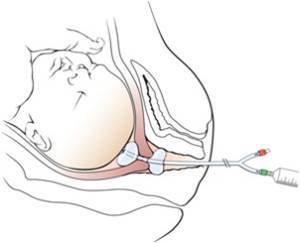There are various ways of inducing labour. Sometimes a couple of methods are combined.
Membrane sweeping
This may be done by the midwife or doctor placing her finger inside your cervix and making a circular movement to separate the membranes from the cervix. This encourages your waters to break and labour to start naturally. It may cause some discomfort and light bleeding.
The midwife can visit you at home to sweep the membranes or it can be done by the midwife or doctor in the clinic or on the antenatal ward.
Balloon
Cook balloon is a slim silicone tube with two inflatable balloons which act to ripen and dilate the cervix. It can be inserted by a doctor or midwife. Once the inserted they are inflated with salt water (normal saline). One balloon will be in your uterus and the other in your vagina. The balloons do not contain any medication, but their presence there encourages natural labour to begin. Once inserted, the balloons will stay inside usually for 12 hours.
You may be able to go home during this period. While the balloons are inside, you are safe to mobilize and eat as normal.
You should contact your midwife if:
you have regular contractions
your waters break
you have bleeding
you have any concerns
The balloon will be deflated and removed if it has not fallen out by the time you are seen again. An internal exam will be conducted to assess suitability for your waters to be broken. If your cervix has not changed, you may need prostaglandins or other interventions.

Prostaglandin
Prostaglandin is a hormone which is released naturally by the cervix during labour to stimulate contractions. Giving prostaglandin helps make the process close to natural labour.
Prostaglandin gel is placed into your vagina by the midwife on the antenatal ward. The prostaglandin encourages your cervix to open, your waters to break and your contractions to start.
The midwife will insert the prostaglandin gel when you are on the antenatal ward. You will have to lie down for 1 hour after being given the prostaglandin while we monitor your baby’s heart beat, but then you will be able to get up and move around. Further doses can be given if needed.
Amniotomy
This is another method used to help start labour, also called artificial rupturing of the membranes or ‘breaking the waters’. This encourages the womb to contract to start labour. A small hook is inserted into your vagina to do this and it won't touch your baby.
This procedure is usually done in the labour ward.
Oxytocin
This method is usually used following one, or both of the above methods, generally if your waters have broken but your contractions have not started. Oxytocin is a natural hormone which builds up during labour and causes contractions.
During induction, Oxytocin is given into your vein via a drip. A doctor or midwife in the delivery suite will attach the drip to your arm. Once the drip is put into your arm, you might not be able to walk around.
Will it be painful?
Induction is generally no more painful than a natural birth.
How long will it take?
Your baby won't necessarily be born on the day that you come in to be induced. The process of induction varies a great deal from woman to woman. It is hard to say when it will start or how long it will take but, as with natural labour, induction takes two or three days on average. Pain relief will be available.
Occasionally a round of Induction may not work - if this happens the Doctor will discuss with you a second round of induction. There will be a period of 'rest' between the first and second induction process and it is likely you would be able to go home during this time.



